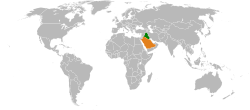Saudi–Iraq border

The Saudi–Iraq border is stretching from Turaif near the Jordanian border in the West to Hafar Al-Batin near the Kuwaiti border in the East. It is 814 km long. The most important border crossing is situated North-East from Arar.
Barrier
| Saudi–Iraq barrier | |
|---|---|
| Saudi Arabia–Iraq border | |
| Type | Border barrier |
| Site information | |
| Controlled by | Saudi Arabian Army |
| Condition | Active |
| Site history | |
| Built | 2014 |
| Built by | Kingdom of Saudi Arabia |
| In use | 2014–present |
| Battles/wars | Iraq War (2014–present) |
In April 2006, while Iraq was experiencing a high level of sectarian violence, Saudi Arabia began to call for tenders to construct a border barrier in the form of a fence along the border in an attempt to prevent the violence in Iraq spilling over into Saudi Arabia.[1]
The proposed fence would run for approximately 900 kilometres (560 mi) along Saudi Arabia's isolated northern desert border with Iraq. It was part of a larger package of fence-building to secure all of the Kingdom of Saudi Arabia's 6,500 kilometers of border. It would supplement the existing 7-meter-high sand berm that runs along the border, in front of which there is an 8-kilometer stretch of no-mans-land which is regularly swept smooth so that trespassers can be tracked.[2]
The proposals were not implemented until September 2014, when the Iraq War had escalated following the rise of the Islamic State of Iraq and the Levant. ISIL's occupation of much of western Iraq had given it a substantial land border with Saudi Arabia to the south, and the barrier is intended to keep ISIL militants from entering Saudi Arabia.[3]
The line consists of a multi-layered fence and ditch barrier wall. The border zone includes five layers of fencing with includes 78 monitoring watch towers, night-vision cameras, and radar cameras, eight command centres, 10 mobile surveillance vehicles, 32 rapid-response centres, and three rapid intervention squads.[4][5]
The barrier is sometimes referred to as the Great Wall of Saudi Arabia.[6] The works are done by Airbus Group, formerly EADS.
See also
References
- ↑ Krane, Jim (27 September 2006). "Saudis Plan Long Fence for Iraq Border". The Washington Post. Retrieved 11 August 2015.
- ↑ Smith, Stephen (18 January 2006). "A Line In The Saudi Sand". CBS News. Retrieved 11 August 2015.
- ↑ Spencer, Richard (14 January 2015). "Saudi Arabia Is Building A 600-Mile 'Great Wall' To Shield Itself From ISIS". Business Insider. Retrieved 18 January 2015.
- ↑ Binnie, Jeremy (11 September 2014). "Saudi Arabia inaugurates northern border security project". janes.com. Retrieved 18 January 2015.
- ↑ http://www.telegraph.co.uk/news/worldnews/middleeast/saudiarabia/11344116/Revealed-Saudi-Arabias-Great-Wall-to-keep-out-Isil.html
- ↑ Gayle, Damien (16 January 2015). "The Great Wall of Saudi Arabia: Kingdom plans to build 600-mile barrier from Jordan to Kuwait in response to the threat of an invasion by ISIS". Daily Mail. Retrieved 18 January 2015.